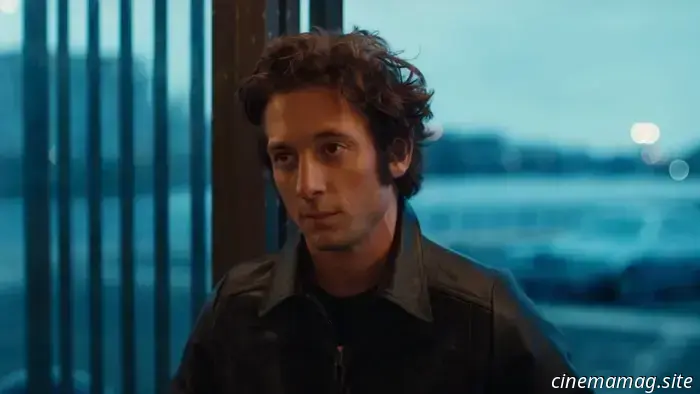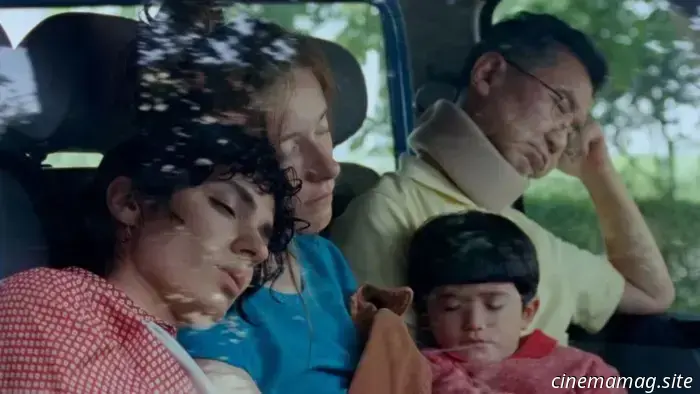
In the trailer for 'Springsteen: Deliver Me From Nowhere,' Jeremy Allen White is portrayed as 'Searching for Something Genuine.'
Credit: 20th Century Studios
In the latest trailer for Springsteen: Deliver Me From Nowhere, Jeremy Allen White, known for his role in The Bear, embodies Bruce Springsteen during a pivotal moment in his career: the creation of Nebraska.
While the film is not a traditional biopic, it focuses on a brief yet significant time in Springsteen's artistic journey. In 1982, as his record label pursued a top ten hit, Springsteen chose to record quiet, dark, and introspective acoustic songs, including "Atlantic City," a haunting narrative of mob violence featured in the trailer.
He largely recorded these tracks on a four-track machine in his bedroom in New Jersey.
“This film delves deeply into a couple of years of my life, focusing on the time I made Nebraska and faced some personal challenges,” Springsteen remarked in a statement released on Sunday. “I am incredibly grateful to Jeremy Allen White and the whole cast for their remarkable and poignant performances — and to Scott Cooper, one of the most generous collaborators I’ve had the pleasure of working with.”
Along with a striking physical resemblance, White skillfully mimics Springsteen’s vocal nuances as he expresses himself in the film's trailer: “I’m tryin’ to find something real.”
What he discovered included profoundly personal songs as well as pieces influenced by Terrence Malick’s film, Badlands.
If you don’t see it above, you can watch the trailer here.
Details about Springsteen: Deliver Me From Nowhere, Featuring Jeremy Allen White as Bruce Springsteen
Adapted from Warren Zanes’ book of the same title, Springsteen: Deliver Me from Nowhere is directed by Scott Cooper (Hostiles) and features Jeremy Strong as Jon Landau, Springsteen’s long-time confidant and manager; Paul Walter Hauser as guitar technician Mike Batlan; Odessa Young as Faye; Stephen Graham as Doug, Springsteen’s father; Gaby Hoffman as his mother, Adele; and David Krumholtz as Columbia executive Al Teller.
“Nebraska represents the moment when Bruce prioritized authenticity over expectation — a decision that continues to influence everything he has created since. At that turning point, he could have pursued fame and arena applause, but instead chose to turn inward, equipped only with silence, a four-track recorder, and the bravery to confront himself. It’s an incredible honor for him to trust me with portraying that story — the most vulnerable chapter of his life — as a filmmaker,” Cooper stated.
Screenshot – Credit: 20th Century Studios
The trailer was unveiled during Sunday evening’s Emmys, an event where The Bear has previously excelled.
After its premiere this month at the Telluride Film Festival, the film currently boasts a 100% rating on Rotten Tomatoes. It is produced by Cooper, Ellen Goldsmith-Vein, Eric Robinson, and Scott Stuber, with executive producers Tracey Landon, Jon F. Vein, and Zanes. The film features an original score by composer Jeremiah Fraites, cinematography by Masanobu Takayanagi, production design by Stefania Cella, costume design by Kasia Walicka-Maimone, and editing by Pamela Martin.
Springsteen: Deliver Me from Nowhere is set to release in theaters on October 24 through 20th Century Studios.


Other articles
 Folk horror film Dolly releases trailer in anticipation of its world premiere at Fantastic Fest.
Before its world premiere at Fantastic Fest later this month, a trailer has been released online for Rod Blackhurst's folk horror film, Dolly. The story centers on a young woman's battle for survival after being kidnapped by a crazed creature. The cast includes Fabianne Therese, Seann William Scott, Ethan Suplee, and Max the Impaler. Check […]
Folk horror film Dolly releases trailer in anticipation of its world premiere at Fantastic Fest.
Before its world premiere at Fantastic Fest later this month, a trailer has been released online for Rod Blackhurst's folk horror film, Dolly. The story centers on a young woman's battle for survival after being kidnapped by a crazed creature. The cast includes Fabianne Therese, Seann William Scott, Ethan Suplee, and Max the Impaler. Check […]
 The Must-See Action Films by Cannon Films
Casey Chong discusses the iconic action films produced by Cannon Films... If you experienced the 80s and 90s, you probably recognized Cannon Films, an independent production company known for its low-budget B-movies that concentrated on genres like action, martial arts, and sci-fi & fantasy. Cannon started off with a […]
The Must-See Action Films by Cannon Films
Casey Chong discusses the iconic action films produced by Cannon Films... If you experienced the 80s and 90s, you probably recognized Cannon Films, an independent production company known for its low-budget B-movies that concentrated on genres like action, martial arts, and sci-fi & fantasy. Cannon started off with a […]
 Hannah Einbinder during her Emmy speech stated: "F--- ICE, Free Palestine."
Hannah Einbinder stated "fuck ICE, free Palestine" while accepting her Emmy Award for Outstanding Supporting Actress in a Comedy Series.
Hannah Einbinder during her Emmy speech stated: "F--- ICE, Free Palestine."
Hannah Einbinder stated "fuck ICE, free Palestine" while accepting her Emmy Award for Outstanding Supporting Actress in a Comedy Series.
 Exclusive: Japan Society Unveils October Series Featuring Shiguéhiko Hasumi: A Different Perspective on Cinema in America and Japan.
In a recent addition to the race for series of the year, New York's Japan Society has granted complete freedom in programming to Shiguéhiko Hasumi––a critic, theorist, and scholar who has also mentored Kiyoshi Kurosawa. The outcome is Shiguéhiko Hasumi: Another History of the Movie in America and Japan, scheduled to take place from October 9 to 18 and
Exclusive: Japan Society Unveils October Series Featuring Shiguéhiko Hasumi: A Different Perspective on Cinema in America and Japan.
In a recent addition to the race for series of the year, New York's Japan Society has granted complete freedom in programming to Shiguéhiko Hasumi––a critic, theorist, and scholar who has also mentored Kiyoshi Kurosawa. The outcome is Shiguéhiko Hasumi: Another History of the Movie in America and Japan, scheduled to take place from October 9 to 18 and
 In *The Lost Bus*, the latest gripping and adrenaline-fueled disaster thriller by Paul Greengrass, a few electric sparks from a major power line ignite dry grasses, leading to an uncontrollable wildfire that devastatingly consumes Paradise, California. The town's name carries a tragic irony, as the horrific flames of the 2018 Camp Fire transformed this arid mountainous area into an unimaginable hell, resulting in 85 fatalities and incurring $13.5 billion in damages. Drawing from stories that surfaced amid the ruins, including accounts from Lizzie Johnson’s detailed narrative *Paradise: One Town’s Struggle to Survive an American Wildfire*, the film counters the destruction by focusing on an act of heroism through the lens of an underdog narrative that acts as a temporary comfort amidst the state’s otherwise grim and scorched reality.
There is much to illustrate in a natural disaster of this magnitude, and Greengrass, who co-wrote the script with Brad Inglesby, swiftly navigates through burned landscapes to various emergency services and response teams. However, the protagonist at the center of this overwhelming day in November is Kevin McKay (Matthew McConaughey), a school-bus driver who has recently returned to his hometown after burying his father. At the start of *The Lost Bus*, he is still grappling with his father’s death but faces even greater worries: his dog's cancer has progressed, his son is sick and refuses to talk to him, his mother struggles to care for herself, and his ex-wife criticizes his parenting over the phone. Compounding his troubles, he is short on money, unable to persuade his supervisor for extra shifts, and late for a required bus maintenance check. When smoke begins to billow, McKay's troubled situation and tardiness make him the sole driver capable of altering his route to rescue 23 stranded schoolchildren and their teacher, Mary Ludwick (America Ferrera), transporting them to safety. It poses a potential death trap, yet also presents an opportunity for redemption.
Greengrass possesses a remarkable talent for portraying disaster—the kind of dynamic, high-stakes action that continuously builds and evolves—which makes it easy to overlook how few directors manage to do it effectively. In the past, Greengrass pioneered a new wave of action films with his handheld, shaky-camera style in blockbuster hits like *The Bourne Supremacy* and *The Bourne Ultimatum*. This approach transitioned into a series of docudramas and nonfiction thrillers, including *United 93*, *Captain Phillips*, and *July 22*. Although his frenetic and jarring style (which may not appeal to everyone) has fallen out of favor in recent years, he developed a visual language that captured the intense, real-world experiences of various terror groups and those rising to confront them.
In this case, the adversary is nature itself, and Greengrass finds his stride after setting up the necessary context and backstories. He has honed the formula for dynamic characters, providing them with enough background and personality that the audience feels invested when they encounter harrowing situations. There are ample moments here to keep viewers engaged—close calls and near escapes that emphasize the school bus’s cumbersome mechanics amid congested traffic and chaotic intersections. The unpredictability of the flames adds to the tension, overwhelming the windows and floors, causing the children on board to panic or fall silent in fear. Greengrass keeps the audience on edge not through manipulative drama, but by knowing when to cut, when to slow down, and when to go full throttle.
This blend of technique is an art form in itself. However, much of its effectiveness hinges on the characters navigating the disaster. Greengrass is fortunate to have McConaughey, who seems naturally suited for intense situations. As a rare movie star who can don dirt and a baseball cap to fit seamlessly into a blue-collar community, McConaughey conveys the horror through the windshield with a slack-jawed demeanor, ultimately emerging as a decisive leader. He complements Ferrera, who joins the bus somewhat unaware of the impending firestorm while maintaining her composure for the sake of her students. Capturing that dynamic can be challenging, but the film shines brightest when both characters are compelled to step outside their established roles—to scout the fire, secure resources, take the wheel, or calm the frightened children. In a scenario that risks exaggerating clumsiness or anxiety to heighten the stakes, it’s refreshing to see two characters adapt to their surroundings with determined and believable efforts. Greengrass recognizes that the situation is already dire; he doesn’t need to fabricate unnecessary theatrics for emotional impact.
One of Greengrass's most impactful decisions is to personify the wildfire, incorporating point-of-view shots using a windswept camera that rushes through mountains, across power lines, and over bustling roads. He frames the flames as the true antagonist of the film, lending a more
Originating from the wartime screenings organized by Mirsad Purivatra and Izeta Građević in the early '90s, no festival around the globe embodies its history like the Sarajevo Film Festival. The city was still under siege when residents started evading sniper fire to reach the basement of the Apollo theatre for
In *The Lost Bus*, the latest gripping and adrenaline-fueled disaster thriller by Paul Greengrass, a few electric sparks from a major power line ignite dry grasses, leading to an uncontrollable wildfire that devastatingly consumes Paradise, California. The town's name carries a tragic irony, as the horrific flames of the 2018 Camp Fire transformed this arid mountainous area into an unimaginable hell, resulting in 85 fatalities and incurring $13.5 billion in damages. Drawing from stories that surfaced amid the ruins, including accounts from Lizzie Johnson’s detailed narrative *Paradise: One Town’s Struggle to Survive an American Wildfire*, the film counters the destruction by focusing on an act of heroism through the lens of an underdog narrative that acts as a temporary comfort amidst the state’s otherwise grim and scorched reality.
There is much to illustrate in a natural disaster of this magnitude, and Greengrass, who co-wrote the script with Brad Inglesby, swiftly navigates through burned landscapes to various emergency services and response teams. However, the protagonist at the center of this overwhelming day in November is Kevin McKay (Matthew McConaughey), a school-bus driver who has recently returned to his hometown after burying his father. At the start of *The Lost Bus*, he is still grappling with his father’s death but faces even greater worries: his dog's cancer has progressed, his son is sick and refuses to talk to him, his mother struggles to care for herself, and his ex-wife criticizes his parenting over the phone. Compounding his troubles, he is short on money, unable to persuade his supervisor for extra shifts, and late for a required bus maintenance check. When smoke begins to billow, McKay's troubled situation and tardiness make him the sole driver capable of altering his route to rescue 23 stranded schoolchildren and their teacher, Mary Ludwick (America Ferrera), transporting them to safety. It poses a potential death trap, yet also presents an opportunity for redemption.
Greengrass possesses a remarkable talent for portraying disaster—the kind of dynamic, high-stakes action that continuously builds and evolves—which makes it easy to overlook how few directors manage to do it effectively. In the past, Greengrass pioneered a new wave of action films with his handheld, shaky-camera style in blockbuster hits like *The Bourne Supremacy* and *The Bourne Ultimatum*. This approach transitioned into a series of docudramas and nonfiction thrillers, including *United 93*, *Captain Phillips*, and *July 22*. Although his frenetic and jarring style (which may not appeal to everyone) has fallen out of favor in recent years, he developed a visual language that captured the intense, real-world experiences of various terror groups and those rising to confront them.
In this case, the adversary is nature itself, and Greengrass finds his stride after setting up the necessary context and backstories. He has honed the formula for dynamic characters, providing them with enough background and personality that the audience feels invested when they encounter harrowing situations. There are ample moments here to keep viewers engaged—close calls and near escapes that emphasize the school bus’s cumbersome mechanics amid congested traffic and chaotic intersections. The unpredictability of the flames adds to the tension, overwhelming the windows and floors, causing the children on board to panic or fall silent in fear. Greengrass keeps the audience on edge not through manipulative drama, but by knowing when to cut, when to slow down, and when to go full throttle.
This blend of technique is an art form in itself. However, much of its effectiveness hinges on the characters navigating the disaster. Greengrass is fortunate to have McConaughey, who seems naturally suited for intense situations. As a rare movie star who can don dirt and a baseball cap to fit seamlessly into a blue-collar community, McConaughey conveys the horror through the windshield with a slack-jawed demeanor, ultimately emerging as a decisive leader. He complements Ferrera, who joins the bus somewhat unaware of the impending firestorm while maintaining her composure for the sake of her students. Capturing that dynamic can be challenging, but the film shines brightest when both characters are compelled to step outside their established roles—to scout the fire, secure resources, take the wheel, or calm the frightened children. In a scenario that risks exaggerating clumsiness or anxiety to heighten the stakes, it’s refreshing to see two characters adapt to their surroundings with determined and believable efforts. Greengrass recognizes that the situation is already dire; he doesn’t need to fabricate unnecessary theatrics for emotional impact.
One of Greengrass's most impactful decisions is to personify the wildfire, incorporating point-of-view shots using a windswept camera that rushes through mountains, across power lines, and over bustling roads. He frames the flames as the true antagonist of the film, lending a more
Originating from the wartime screenings organized by Mirsad Purivatra and Izeta Građević in the early '90s, no festival around the globe embodies its history like the Sarajevo Film Festival. The city was still under siege when residents started evading sniper fire to reach the basement of the Apollo theatre for
 Repurposed Stellantis EV batteries embark on a new journey powering an Italdesign-designed mobility vehicle
9 hours ago
by Thanos Pappas
Stellantis provides second-life EV batteries for the Avathor One.
This electric vehicle was designed by Italdesign, a member of the VW Group.
The reconfigured modules allow for a range of 50 km (31 mph) between charges.
The auto industry is increasingly focusing on finding new roles for used car batteries, and Stellantis has discovered a particularly user-oriented application. Instead of allowing end-of-life EV packs to remain unused, the company is reimagining them for mobility solutions beyond conventional vehicles.
More: Stellantis Is Quietly Developing A Tri-Motor EV Setup That Can Self-Power
One of the most fascinating examples arises from a partnership with startup Avathor, which has created a compact EV designed specifically for wheelchair users and those with reduced mobility. Adding an extra layer of interest is the fact that the vehicle was designed by Italdesign, a member of the Volkswagen Group.
This unique collaboration between Stellantis and the VW Group likely originates from both Avathor and Italdesign being located in Turin, which is also a significant center for Stellantis, housing the Mirafiori facilities and the company’s main European headquarters.
From Road To Renewal
The process starts with Stellantis brands collecting batteries from retired EVs. These packs are sent to Turin, where SUSTAINera, Stellantis’ branch focused on the circular economy, works to maximize their utility and minimize waste. A local partner, Intent S.r.l., then breaks down the 15 kWh modules and repackages them for new applications.
For the Avathor One, the modules are redeveloped into 1.4 kWh short-range or 2.8 kWh long-range batteries, providing up to 50 km (31 mph) between charges, with a maximum speed limited to 10 km/h (6 mph).
Avathor / Italdesign
What Is The Avathor One?
The Avathor One was introduced earlier this year as the production model based on the innovative 2019 WheeM-i concept created by Italdesign. It features a rear ramp for wheelchair access, a pull-out bench, and joystick controls.
Measuring just 1,486 mm (58.5 inches) long, this EV incorporates car-like elements such as LED headlights, a rearview camera, and collision-avoidance sensors that detect both obstacles and pedestrians. It can manage inclines of up to 20 percent and navigate steps up to 8 cm (3 inches) high.
According to the company, the aim is to launch the Avathor in Italy later this year, followed by Spain in 2026 and additional markets in 2027.
Beyond Mobility Aids
In addition to the Avathor initiative, Stellantis SUSTAINera is also collaborating with utility companies and battery integrators. A notable example is the ENEL X Pioneer system, which stores renewable energy at Rome’s Fiumicino Airport and is expected to reduce CO2 emissions by 16,000 tons over a decade.
Certainly, Stellantis is not the only automaker engaged in the circular economy with second-life batteries. Other companies such as Nissan, Renault, BMW, Kia, Geely, Jaguar, Toyota, Honda, Skoda, and Audi are also involved in similar initiatives.
In honor of the 40th anniversary of the beloved American sitcom, NECA has officially released its deluxe action figure 4-pack of The Golden Girls. This collectible set includes figures of Dorothy, Sophia, Blanche, and Rose, and is currently available for pre-order at a price of $100. Take a look at the promotional images here... Celebrate four decades of the iconic TV comedy series that [...]
Repurposed Stellantis EV batteries embark on a new journey powering an Italdesign-designed mobility vehicle
9 hours ago
by Thanos Pappas
Stellantis provides second-life EV batteries for the Avathor One.
This electric vehicle was designed by Italdesign, a member of the VW Group.
The reconfigured modules allow for a range of 50 km (31 mph) between charges.
The auto industry is increasingly focusing on finding new roles for used car batteries, and Stellantis has discovered a particularly user-oriented application. Instead of allowing end-of-life EV packs to remain unused, the company is reimagining them for mobility solutions beyond conventional vehicles.
More: Stellantis Is Quietly Developing A Tri-Motor EV Setup That Can Self-Power
One of the most fascinating examples arises from a partnership with startup Avathor, which has created a compact EV designed specifically for wheelchair users and those with reduced mobility. Adding an extra layer of interest is the fact that the vehicle was designed by Italdesign, a member of the Volkswagen Group.
This unique collaboration between Stellantis and the VW Group likely originates from both Avathor and Italdesign being located in Turin, which is also a significant center for Stellantis, housing the Mirafiori facilities and the company’s main European headquarters.
From Road To Renewal
The process starts with Stellantis brands collecting batteries from retired EVs. These packs are sent to Turin, where SUSTAINera, Stellantis’ branch focused on the circular economy, works to maximize their utility and minimize waste. A local partner, Intent S.r.l., then breaks down the 15 kWh modules and repackages them for new applications.
For the Avathor One, the modules are redeveloped into 1.4 kWh short-range or 2.8 kWh long-range batteries, providing up to 50 km (31 mph) between charges, with a maximum speed limited to 10 km/h (6 mph).
Avathor / Italdesign
What Is The Avathor One?
The Avathor One was introduced earlier this year as the production model based on the innovative 2019 WheeM-i concept created by Italdesign. It features a rear ramp for wheelchair access, a pull-out bench, and joystick controls.
Measuring just 1,486 mm (58.5 inches) long, this EV incorporates car-like elements such as LED headlights, a rearview camera, and collision-avoidance sensors that detect both obstacles and pedestrians. It can manage inclines of up to 20 percent and navigate steps up to 8 cm (3 inches) high.
According to the company, the aim is to launch the Avathor in Italy later this year, followed by Spain in 2026 and additional markets in 2027.
Beyond Mobility Aids
In addition to the Avathor initiative, Stellantis SUSTAINera is also collaborating with utility companies and battery integrators. A notable example is the ENEL X Pioneer system, which stores renewable energy at Rome’s Fiumicino Airport and is expected to reduce CO2 emissions by 16,000 tons over a decade.
Certainly, Stellantis is not the only automaker engaged in the circular economy with second-life batteries. Other companies such as Nissan, Renault, BMW, Kia, Geely, Jaguar, Toyota, Honda, Skoda, and Audi are also involved in similar initiatives.
In honor of the 40th anniversary of the beloved American sitcom, NECA has officially released its deluxe action figure 4-pack of The Golden Girls. This collectible set includes figures of Dorothy, Sophia, Blanche, and Rose, and is currently available for pre-order at a price of $100. Take a look at the promotional images here... Celebrate four decades of the iconic TV comedy series that [...]
In the trailer for 'Springsteen: Deliver Me From Nowhere,' Jeremy Allen White is portrayed as 'Searching for Something Genuine.'
In the latest Springsteen: Deliver Me From Nowhere trailer, The Bear actor Jeremy Allen White embodies the Boss at a pivotal moment in his career: during
